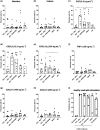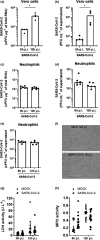Kinetics of peripheral blood neutrophils in severe coronavirus disease 2019
- PMID: 33968405
- PMCID: PMC8082714
- DOI: 10.1002/cti2.1271
Kinetics of peripheral blood neutrophils in severe coronavirus disease 2019
Abstract
Objectives: Emerging evidence of dysregulation of the myeloid cell compartment urges investigations on neutrophil characteristics in coronavirus disease 2019 (COVID-19). We isolated neutrophils from the blood of COVID-19 patients receiving general ward care and from patients hospitalised at intensive care units (ICUs) to explore the kinetics of circulating neutrophils and factors important for neutrophil migration and activation.
Methods: Multicolour flow cytometry was exploited for the analysis of neutrophil differentiation and activation markers. Multiplex and ELISA technologies were used for the quantification of protease, protease inhibitor, chemokine and cytokine concentrations in plasma. Neutrophil polarisation responses were evaluated microscopically. Gelatinolytic and metalloproteinase activity in plasma was determined using a fluorogenic substrate. Co-culturing healthy donor neutrophils with severe acute respiratory syndrome coronavirus 2 (SARS-CoV-2) allowed us to investigate viral replication in neutrophils.
Results: Upon ICU admission, patients displayed high plasma concentrations of granulocyte-colony-stimulating factor (G-CSF) and the chemokine CXCL8, accompanied by emergency myelopoiesis as illustrated by high levels of circulating CD10-, immature neutrophils with reduced CXCR2 and C5aR expression. Neutrophil elastase and non-metalloproteinase-derived gelatinolytic activity were increased in plasma from ICU patients. Significantly higher levels of circulating tissue inhibitor of metalloproteinase 1 (TIMP-1) in patients at ICU admission yielded decreased total MMP proteolytic activity in blood. COVID-19 neutrophils were hyper-responsive to CXCL8 and CXCL12 in shape change assays. Finally, SARS-CoV-2 failed to replicate inside human neutrophils.
Conclusion: Our study provides detailed insights into the kinetics of neutrophil phenotype and function in severe COVID-19 patients, and supports the concept of an increased neutrophil activation state in the circulation.
Keywords: COVID‐19; chemokine; cytokine; emergency myelopoiesis; neutrophil; protease.
© 2021 The Authors. Clinical & Translational Immunology published by John Wiley & Sons Australia, Ltd on behalf of Australian and New Zealand Society for Immunology, Inc.
Conflict of interest statement
The authors declare that no conflict of interest exists.
Figures





Similar articles
-
CSL324, a granulocyte colony-stimulating factor receptor antagonist, blocks neutrophil migration markers that are upregulated in hidradenitis suppurativa.Br J Dermatol. 2023 Apr 20;188(5):636-648. doi: 10.1093/bjd/ljad013. Br J Dermatol. 2023. PMID: 36691791 Clinical Trial.
-
Decidua-derived granulocyte macrophage colony-stimulating factor induces polymorphonuclear myeloid-derived suppressor cells from circulating CD15+ neutrophils.Hum Reprod. 2020 Dec 1;35(12):2677-2691. doi: 10.1093/humrep/deaa217. Hum Reprod. 2020. PMID: 33067638
-
Circulating granulocyte macrophage colony-stimulating factor in plasma of patients with the systemic inflammatory response syndrome delays neutrophil apoptosis through inhibition of spontaneous reactive oxygen species generation.Shock. 1999 Mar;11(3):167-74. doi: 10.1097/00024382-199903000-00003. Shock. 1999. PMID: 10188768 Clinical Trial.
-
Neutrophil activation and neutrophil extracellular traps (NETs) in COVID-19 ARDS and immunothrombosis.Eur J Immunol. 2023 Jan;53(1):e2250010. doi: 10.1002/eji.202250010. Epub 2022 Nov 1. Eur J Immunol. 2023. PMID: 36239164 Free PMC article. Review.
-
Disruption of CCR5 signaling to treat COVID-19-associated cytokine storm: Case series of four critically ill patients treated with leronlimab.J Transl Autoimmun. 2021;4:100083. doi: 10.1016/j.jtauto.2021.100083. Epub 2021 Jan 6. J Transl Autoimmun. 2021. PMID: 33521616 Free PMC article. Review.
Cited by
-
Transcriptional reprogramming of infiltrating neutrophils drives lung pathology in severe COVID-19 despite low viral load.Blood Adv. 2023 Mar 14;7(5):778-799. doi: 10.1182/bloodadvances.2022008834. Blood Adv. 2023. PMID: 36399523 Free PMC article.
-
Detection of Antinuclear Antibodies Targeting Intracellular Signal Transduction, Metabolism, Apoptotic Processes and Cell Death in Critical COVID-19 Patients.Mediterr J Hematol Infect Dis. 2022 Nov 1;14(1):e2022076. doi: 10.4084/MJHID.2022.076. eCollection 2022. Mediterr J Hematol Infect Dis. 2022. PMID: 36425144 Free PMC article.
-
Dynamic Changes of the Neutrophil-to-Lymphocyte Ratio, Systemic Inflammation Index, and Derived Neutrophil-to-Lymphocyte Ratio Independently Predict Invasive Mechanical Ventilation Need and Death in Critically Ill COVID-19 Patients.Biomedicines. 2021 Nov 10;9(11):1656. doi: 10.3390/biomedicines9111656. Biomedicines. 2021. PMID: 34829883 Free PMC article.
-
Alpha-2-Macroglobulin in Inflammation, Immunity and Infections.Front Immunol. 2021 Dec 14;12:803244. doi: 10.3389/fimmu.2021.803244. eCollection 2021. Front Immunol. 2021. PMID: 34970276 Free PMC article. Review.
-
The chemokines CXCL8 and CXCL12: molecular and functional properties, role in disease and efforts towards pharmacological intervention.Cell Mol Immunol. 2023 Mar;20(3):217-251. doi: 10.1038/s41423-023-00974-6. Epub 2023 Feb 1. Cell Mol Immunol. 2023. PMID: 36725964 Free PMC article. Review.
References
-
- Wu Z, McGoogan JM. Characteristics of and important lessons from the Coronavirus Disease 2019 (COVID‐19) outbreak in China: summary of a report of 72 314 cases from the Chinese center for disease control and prevention. JAMA 2020; 323: 1239–1242. - PubMed
LinkOut - more resources
Full Text Sources
Other Literature Sources
Research Materials
Miscellaneous
